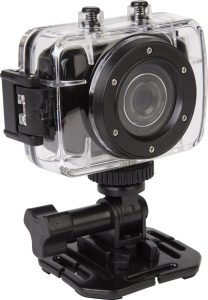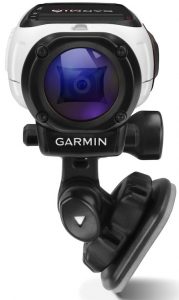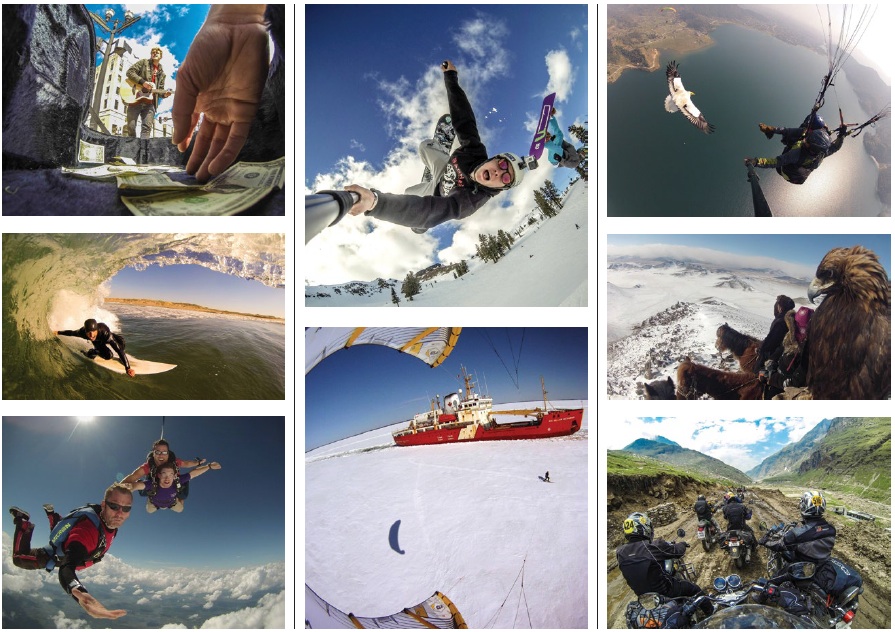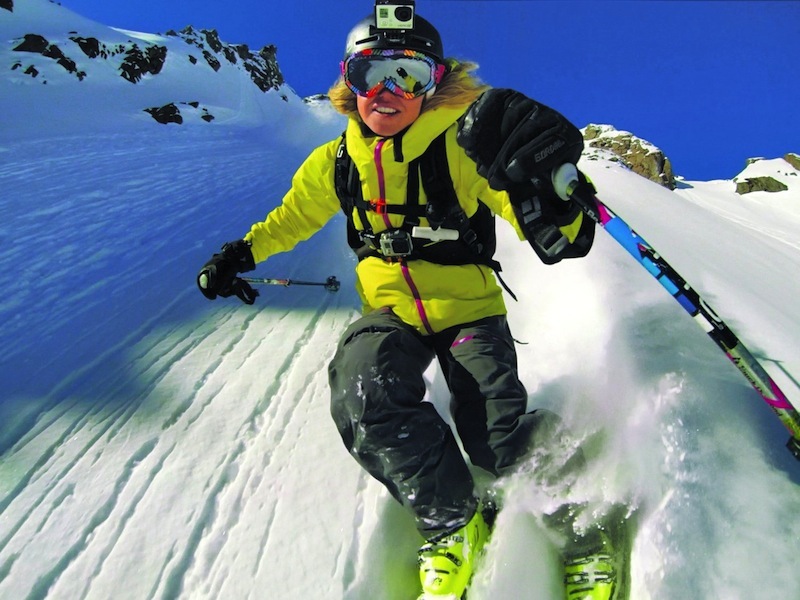When it comes to filming action sequences or high-speed extreme sports, more often than not the go-to piece of equipment would be an action camera. They have been making their mark on consumers ever since they entered into the mainstream segment about six or so years ago. Ever since then, consumers have been strapping them onto helmets, bike handles, canoe paddles and even birds or sharks. The reason they have become so integral to filming high-speed action or extreme sports is that they are incredibly versatile and ultra-portable – sometimes no larger than a computer mouse. But there is also a down side to cramming so much HD technology into a small form-factor – price.
They tend to border on the expensive side, but once the power of these little beauties have been discovered, it becomes incredibly difficult to return to the old ways of the tradition (or dedicated) video camera. There are a number of companies that produce a variety of action cameras, but which one should consumers settle for?
Rollei Bullet Youngstar 720p (R850)
 You could be forgiven if you haven’t heard about Rollei before, but the company has been in the camera producing business since 1902. They established their reputation in the 50s and 60s as a precision manufacturer, and was acquired by RCP-Technik in 2007 – so they have a couple of years of experience. Catering more towards the lower-end of the price spectrum, they have a number of action camera models for all sorts of activities.
You could be forgiven if you haven’t heard about Rollei before, but the company has been in the camera producing business since 1902. They established their reputation in the 50s and 60s as a precision manufacturer, and was acquired by RCP-Technik in 2007 – so they have a couple of years of experience. Catering more towards the lower-end of the price spectrum, they have a number of action camera models for all sorts of activities.
Fractionally bigger than GoPro’s Hero3+, the lightweight plastic casing encompasses everything that users might want to achieve. Operation is fairly simple, as it has a power button and a capture button, both located on the top. It really is a matter of pointing and shooting, with no fuss. Just like the Hero3+, it comes with a waterproof housing and the handling while in the case provide for a similar experience. Although it is impossible to touch the screen while the cover is on.
With a 1.3MP CMOS sensor, users shouldn’t expect award-winning footage, but at least it is in 720p and 30fps. The 135° Wide Angle lens will also help to capture as much as possible, while the electronic shutter speed control and automatic exposure compensation will assist in allowing just the right amount of light to enter the lens. The Youngstar has a fixed-focus lens, yet users can zoom in and out by using the touch screen. While it might seem like a nifty feature to have, the quality of the zoomed-in images deteriorate rather quickly.
The little video camera might not be as powerful at the rest in this supertest, but it can hold its own in the budget range. It features a 2-inch touchscreen at the back, and while it is a nifty thing to have, it is not consistent in sensitivity and pressing some options can be difficult. The waterproof housing is sturdy enough, but users won’t be able to change from video to still images while the housing is on. It also features a rather small battery, as users will only be able to squeeze about 90 minutes out of the unit.
[symple_column size=”one_half”] [symple_box] “Small and inexpensive, a great option for the budget-conscious.”[/symple_box]
Garmin VIRB Elite (R5 599)
 The VIRB is an interesting one in the sense that it is considerably larger than most of the action cameras on the market. Yet, it handles fairly well. In terms of operational use, to start filming all that users have to do is flip a big switch on the side of the body. To take still images, there is a dedicated button for that as well. The unit is also waterproof (IPX7), so it will able to film underwater, as well as take a few knocks. A number of accessories will allow users to slap it on almost anything, improving its usability.
The VIRB is an interesting one in the sense that it is considerably larger than most of the action cameras on the market. Yet, it handles fairly well. In terms of operational use, to start filming all that users have to do is flip a big switch on the side of the body. To take still images, there is a dedicated button for that as well. The unit is also waterproof (IPX7), so it will able to film underwater, as well as take a few knocks. A number of accessories will allow users to slap it on almost anything, improving its usability.
With a 16 megapixel CMOS image processor and WideVü lens, captured videos and still images will be crisp, and pretty much on par with some mid-range compact cameras. As its primary function is to capture video, a number of modes are available: 1080p@30fps, 960p@48fps, 720p@30/60fps, 848×480@120fps. Action sports by nature are fast-paced, so Garmin included a Digital Stabilization to minimize the effects of constant motion. It also includes Photo Burst or Time Lapse modes in 16 megapixels. For stills, 16 megapixel, 12 megapixel or 8 megapixel are selectable.
With a solid body and easy controls, the VIRB is ready to go straight out of the box. It is powered by a 2000 mAh lithium-ion battery, which should give users around three hours of 1080p recording. A bit of a frustration is the screen – it’s a 1.4-inch Chroma Display. In direct sunlight it is virtually impossible to operate, but at least it has a screen to see what is being filmed. Other than that, it operates as it should – recording video and still images with the touch of a button.
[symple_column size=”one_half”] [symple_box] “Slightly bigger than the rest, but still pretty good.” [/symple_box]
GoPro Hero3+ Black Edition (R5 999)
 GoPro has managed to become the quintessential action camera since they introduced their first model in 2005. Since then, the company has produced a great number of different variations, all with differing qualities and strengths. But their flagship model is without a doubt the Hero3+ Black Edition, capturing the imagination and action of brand ambassadors like skateboarder Shaun White and Austrian skydiver Felix Baumgartner.
GoPro has managed to become the quintessential action camera since they introduced their first model in 2005. Since then, the company has produced a great number of different variations, all with differing qualities and strengths. But their flagship model is without a doubt the Hero3+ Black Edition, capturing the imagination and action of brand ambassadors like skateboarder Shaun White and Austrian skydiver Felix Baumgartner.
Measuring in at slightly larger than a matchbox and weighing 136g, it is 20% smaller and lighter than previous GoPro models, making it one of the most portable cameras out there. There is virtually nothing that users have to do in terms of operation (other than setting the mode), as simply pressing one button will do the trick. With only two buttons, navigating the menu options can become a bit of a mission, but practice will make perfect.
With 4K support and a plethora of full-HD recording modes to choose from, users will be spoilt for choice. An ultra-wide angle field of view will capture anything that is in the general vicinity, and the fixed f/2.8 aperture, ultra-sharp 6-element aspherical glass lens ensures that that quality is top-notch. In short, there are very few action HD cameras that can give the Hero3+ a run for its money. In terms of low light performance, GoPro tweaked a number of settings, providing even better quality when the lights are dim. For still images, the camera can shoot at 12MP, and up to 30 frames per second.
Described by the company as “the world’s most versatile camera”, users would be hard-pressed to find reasons why it isn’t. Based purely on performance, the Hero3+ has an excellent track record, but the spot meter can be a bit…er… spotty. It’s also not as fast as the VIRB in terms of taking stills or video, as it takes a couple of seconds to initiate the operation. While the VIRB has a small screen, the Hero3+ doesn’t, so users will have to generally estimate what it is focusing on. It’s not a big issue, as users can pair it with the smartphone app, and operate it through there. It also has a smaller battery than the VIRB, but that can be ascribed to the lack of a display – lasting about two hours when filming in 1080p at 30fps.
[symple_column size=”one_half”] [symple_box] “Tiny as a matchbox, it gets the job done.” [/symple_box]
And the winner is…
While it might seem like the GoPro Hero3+ is the champion of this test, the Garmin VIRB Elite does provide for some stiff competition. The Hero3+ doesn’t have a screen, while the VIRB does… although it’s not fantastic. The VIRB also doesn’t come with a housing, so there might be some trepidation to submerge the camera, while the Hero3+ and the Rollei come with a waterproof housing. The Hero3+ also comes boxed with a rather cool remote control, so user will be able to remotely stop and start recording – especially if the camera is placed on a difficult-to-reach spot.
But going purely by the numbers, the Hero3+ Black Edition does come out on tops, as it has superior image quality, a vast number of recording modes (as well as 4K support) and can take 12MP photos at up to 30 frames per second. It is the most expensive one in the bunch, but if users are willing to fork out R 5 600 for the VIRB, they might as well spend R300 extra and get on of the best action cameras ever produced.


